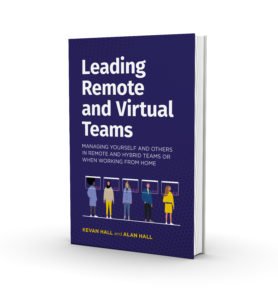What have we learned about working from home? Part 1
Over the last few months we have run webinars for many thousands of people around the world who were new to working from home. We observed that their needs changed as they became more used to the experience. We wanted to capture the learning from this unique period, see if you had similar experiences and make some recommendations on how we embed working from home into the new normal.
As there is quite a lot of content we broke our white paper on working from home into 3 blogs.
- In this blog – part 1 – we will look at the initial concerns that people faced when they suddenly had to work from home, often with little preparation. We will then see how the challenges changed as people started to get used to working from home and needed to make the experience more sustainable.
- In part 2 we will concentrate on the additional people challenges that are coming from a phased return to work and more mixed methods of working. We will identify the trends that are becoming clearer about the new ways of working that will emerge.
- In part 3 we will draw on this learning and our experience of 30 years of training people to work remotely to identify the key individual and management challenges in working from home and what to do about them.
If you can’t wait for all 3 blogs and want to get the whole content as a pdf, please download our white paper on working for home.
The initial challenges
The world’s most rapid and widespread experiment in working from home was necessary but not without its challenges.
Individuals initially struggled with the logistics of working remotely, setting up their offices and IT systems, but most quickly overcame this.
It quickly became evident that there was a huge desire to connect, to share experiences and create a sense of shared community. People became concerned about overcoming isolation, and loneliness. Social media exploded with games, photos and memes about the shared experience.
Some managers struggled with an environment where they could not monitor or control the work their people were doing and worried about productivity. Some corporate cultures were resistant to the idea of working from home, largely around issues of control and security.
Other leaders stepped up and concentrated on creating a sense of virtual community and managing the human factors. Many people noticed an increased “humanisation” of leadership with more care and concern for people and the difficult circumstances we were all living through.
People started to use their existing virtual meetings technologies more actively. Those that didn’t have a platform already downloaded Zoom or another tool for free and got started.
Within a short period of home working a new challenge emerged – days crammed full of Zoom, MS Teams or WebEx calls. People reported a big increase in the number of meetings they were invited to. Some of these replaced face-to-face meetings. Others were driven by a desire to help people feel connected with virtual coffee catch-ups and Friday night video drinks. Still more were scheduled for issues that might have been solved by dropping past a colleague’s desk for 5 minutes or sending an email before the lockdown.
You can see 3 free videos we produced to support people new to working from home around these issues in March/April 2020
- New to working from home – an introduction
- Building community and coping with isolation
- Too many meetings when working from home
Making it sustainable
By the early summer of 2020 it became clear that some individuals would be working remotely for an extended period due to government restrictions, company policies or personal preference.
Several organizations who were able to work remotely announced that they expected this to continue at least until the end of the year.
Others like Slack and Twitter announced that home-based working would become a permanent or part time option. Facebook began recruiting engineers who would work from home permanently.
Individuals started to ask, “why do I need to come back into the office?” Some of this was driven by anxiety about health issues. Many other people had enjoyed the flexibility, and few missed the morning commute.
The majority concluded that they probably would not want to work from home 5 days per week every week, but 2 or 3 days per week working from home would be a benefit.
Organizations started to experience increased productivity as people became used to working from home.
The number of virtual meetings remained a problem and many of these meetings lacked engagement and participation.
Individuals stared to become concerned about work life balance as they struggled to maintain boundaries between work and non-work time. Wellbeing stayed on the agenda.
Some teams found that their social capital started to erode over time. People and teams who knew each other well found they could maintain a sense of community through technology, but that it started to get more challenging to deal with issue the longer they hadn’t met. Other found it hard to onboard new people or to assimilate change without the added bandwidth of face-to-face time.
Individuals started to become concerned about “out of sight out of mind”. How were they going to stay visible to their managers and wider organization? What would be the implications for their performance evaluation and careers as their organizations enter a global recession?
Roles (such as sales) and industries (such as wealth management or professional services) that had relied on traditional meetings and deep relationships with clients, found themselves facing an extended period where they could no longer get face-to-face.
They started to redesign their sales and client contact process and build the skills to get more done through virtual meetings and video calls.
Does this match your experience? Were there additional trends you noticed, we would love to hear about them.
Read our book Leading remote and virtual teams: Managing yourself and others in remote and hybrid teams or when working from home

Download our full white paper on working from home.
You can see more of our insights on working remotely or an interactive graphic of our working from home learning path and module contents.

Explore our training programs to see how we can help.
Agile & Digital Training Matrix Management Training People and purpose Training Virtual Teams TrainingEducate yourself further with a few more or our online insights:
30 years of experience learning with a range of world class clients
We work with a wide range of clients from global multinationals to recent start-ups. Our audiences span all levels, from CEOs to operational teams around the world. Our tools and programs have been developed for diverse and demanding audiences.

Tailored training or off the shelf modules for your people development needs
We are deep content experts in remote, virtual and hybrid working, matrix management and agile & digital leadership. We are highly flexible in how we deliver our content and ideas. We can tailor content closely to your specific needs or deliver off the shelf bite sized modules based on our existing IP and 30 years of training experience.
For more about how we deliver our keynotes, workshops, live web seminars and online learning.